When we talk about a flag, we imagine a cloth flapping in the wind, but in pre-colonial times, there was a completely different approach to symbolism. It was not an aesthetic decoration, but played a much greater role in the self-identification of each tribe through art, dance, totems, and ornaments. For example, traditional patterns on fabrics and shields served as a kind of “flag” that told of heroic deeds or spiritual beliefs. Indigenous peoples chose the sky, earth, sun, and rivers as their “colors”.
With the arrival of the first Europeans, the symbolism began to change gradually. In 1652, the Dutch arrived in the south of the continent and established the so-called “Princely Flag” (Dutch: Prinsenvlag) with three horizontal stripes: orange, white and blue. This flag symbolized the Republic of the United Provinces of the Netherlands and was one of the most famous symbols of Dutch expansion. However, in the Cape Colony, an adapted version of this flag was more often used, created specifically for the Dutch East India Company (VOC).
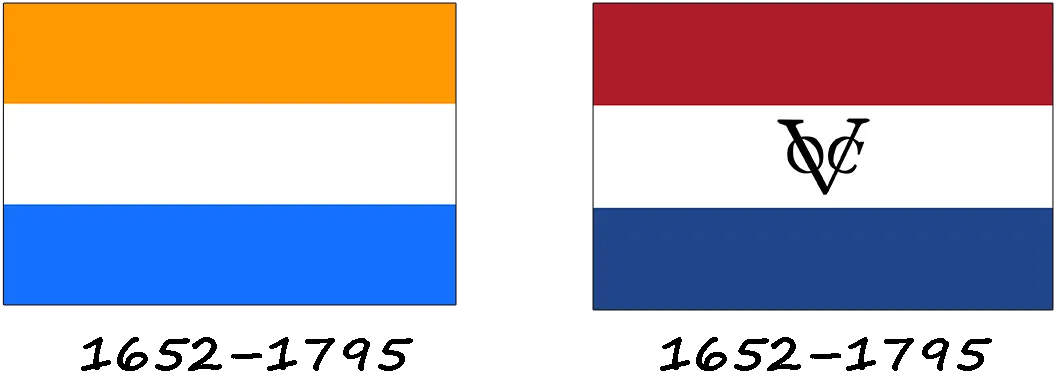
The Cape Colony is one of the first European colonies in Southern Africa, which became a key region in the struggle for control of the strategic route between Europe and Asia. The Cape Colony was founded in 1652 by the Dutch East India Company as an intermediate base for the supply of food, water, and repairs to ships bound for India. The starting point for this was a station in the area of present-day Cape Town, where Jan van Riebeeck led the first Dutch settlement.
The Dutch initially planned to limit themselves to a base, but gradually began to expand the colony's territory by seizing land from indigenous peoples.
The flag of the Cape Colony had three horizontal stripes, but with the addition of the VOC monogram in the center:
- VOC monogram: The letters “V”, “O”, “C” were superimposed on each other and stood for the name “Vereenigde Oostindische Compagnie” (United East India Company);
- Colors: Orange was gradually replaced by red because it was more resistant to fading, but in South Africa the classic orange version remained dominant. Blue also had a darker shade. In general, if you do not take into account the inscription “VOC” in the center, this is a classic modern flag of the Netherlands.
After the capture of the Cape Colony by the British in 1795, the Union Jack, the flag of the United Kingdom of Great Britain and Ireland, became the official flag. However, the use of this flag was not constant and varied depending on the administrative status of the colony.
In 1795, the United Kingdom first seized the Cape Colony, taking advantage of the political weakness of the Netherlands, which was under the control of the French Revolutionary Army. The Cape Colony was strategically important because it provided control over the sea routes to India. The British immediately replaced the colony's flag with the Union Jack, which at the time consisted of crosses of England and Scotland on a blue background. This flag did not yet include the red cross of Ireland, which was added in 1801.
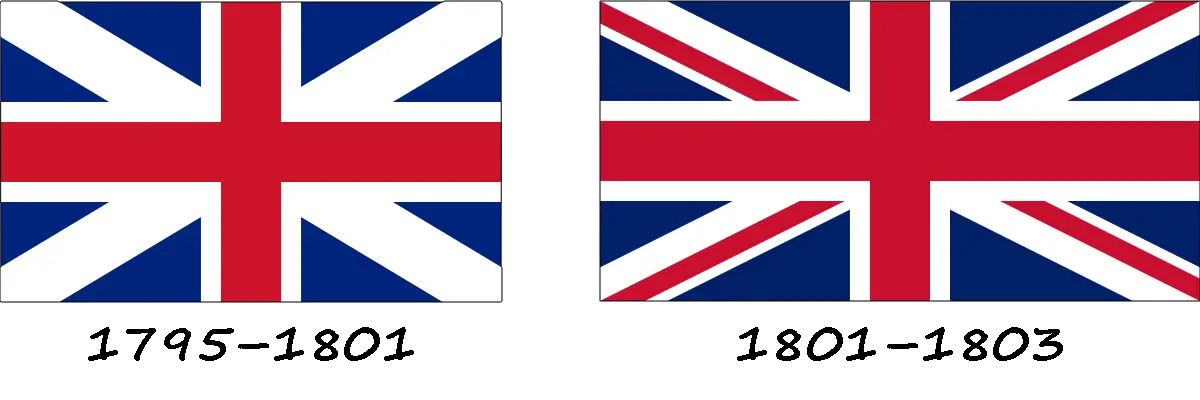
During the first British rule (1795-1803), the Cape Colony became an important point for British merchant ships, but the local population, accustomed to the Dutch administration, was dissatisfied. Under the terms of the Treaty of Amiens, signed on 27.03.1802, the colony was returned to the Netherlands, namely to the Batavia Republic, which resumed using the tricolor flag (red, white and blue).
However, the Netherlands' return to the Cape Colony was short-lived. In 1806, after the Netherlands, under French control, declared war on Great Britain, British troops captured the colony for the second time. The key event of this period was the Battle of Blauberg, which gave the British control of the strategically important Cape of Good Hope. The second British rule lasted until 1815, when, after the end of the Napoleonic Wars and the signing of the relevant treaty, the Netherlands finally ceded the Cape Colony to Great Britain. Since 1815, the colony officially became part of the British Empire, and the symbol of its power remained the Union Jack in its “unchanged” form, i.e. without special colonial insignia. This flag was used in the colony until 1876.
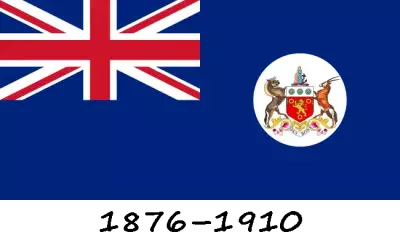
In 1876, the Cape Colony officially adopted a new flag based on the Blue Ensign, a blue flag with a Union Jack in the upper left corner (canton). On the right side of the flag, on a white disk, was the colony's emblem, which was the Cape Colony's coat of arms, approved on May 12, 1875.
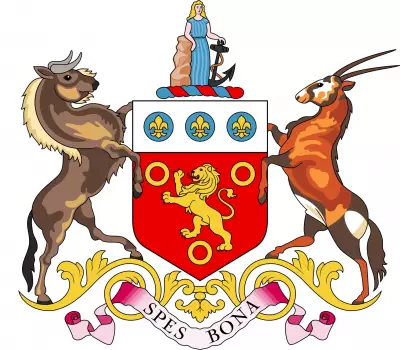
The coat of arms consisted of several elements, each of which had its own symbolic meaning:
- Shield: The main shield is red with the image of a golden lion surrounded by three golden rings. In the upper part of the shield is a silver horizontal belt, on which are placed three golden heraldic lilies, each in a blue disk. These elements were symbols of the colony's connection with the British Empire and the French royal house;
- Crest: Above the shield is the figure of Hope with an anchor. She was an allegorical personification of the colony's hope and optimism;
- Shield supporters: On both sides of the shield are wild animals: Wildebeest on the left and Gemsbok (saber-toothed oryx) on the right. These animals represented the wealth and natural resources of the region;
- Motto: Below the shield, the ribbon bears the colony's motto, “Spes Bona” (Latin for “Good Hope”), which refers to the Cape of Good Hope.
In 1910, the Union of South Africa was established, uniting four colonies - the Cape, Natal, the Orange Free State, and the Transvaal. The main flag was the British Union Jack, but a separate flag based on the Blue Ensign was created for official use.
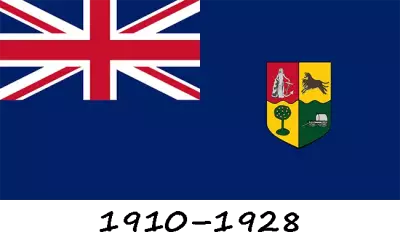
The flag consisted of a blue cloth with the Union Jack in the canton and the coat of arms of the South African Union in the right part. The coat of arms was divided into four parts, each symbolizing one of the colonies:
- The Cape Colony was represented by a female figure, Hope, holding an anchor;
- Natal was symbolized by two antelopes (wildebeests);
- The Orange Free State was depicted as a tree with orange fruits;
- The Transvaal was symbolized by a pioneer cart.
This flag was used mainly for official purposes, as well as on government buildings and courts. Despite this, it did not gain wide popularity among the population. For the English-speaking community, the symbol remained the Union Jack, which was used unofficially, while Africans saw the Blue Ensign as overly dependent on Britain. This split in the perception of the flag reflected the political and cultural tensions between South Africa's two main ethnic groups.
In the 1920s, the issue of national symbolism became increasingly relevant. The Afrikaners wanted a flag that reflected their history and struggle, while the British defended the preservation of British symbols. In 1925, the government began the process of creating a new national flag. After a long debate, a compromise design was adopted that combined elements of British and Afrikaner heritage.
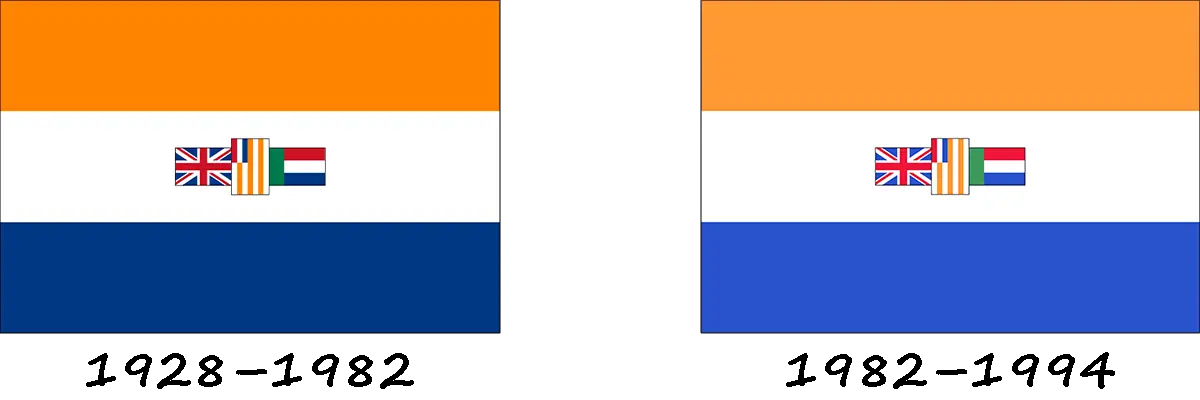
The flag was officially approved on May 31, 1928. It consisted of three horizontal stripes of equal width: the top stripe was orange, the middle stripe was white, and the bottom stripe was blue. The white stripe contained three smaller flags: the Union Jack on the left, the vertical flag of the Orange Free State in the middle, the stripes of white and orange with the vertical flag of the Netherlands in the canton, and the flag of the Transvaal on the right.
The flag of the Transvaal was called Vierkleur (translated from Dutch as “Four-Color”). It consisted of three horizontal stripes (red at the top, white in the middle, and blue at the bottom) and a green vertical element near the pole. The Vierkleur was the official flag of the Republic of South Africa, also known as the Transvaal.
Although the flag was created to reach a compromise between the Afrikaners and the British, its use during the apartheid period contributed to its association with the policy of racial oppression, and for the black population it became a flag of oppression and discrimination.
After the end of apartheid and the first democratic elections in 1994, the current national flag was adopted to reflect the unity and diversity of South Africa.










